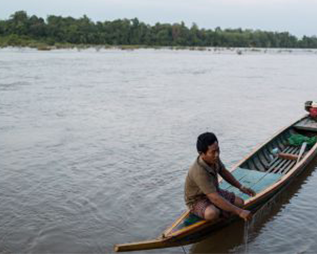other Mekong Projects
Eco-Tourism Project is one of the projects under the sustainable livelihood programmed that provides technical and financial support from Culture and Environment Preservation Association (CEPA). So far, CEPA has supported three sites of eco-tourism along the Mekong Flood Landscape including O’svay (2007), O’Chralang (2017) and Phnom Chamrok Sat (2018). The potential attraction of the eco-tourism site are flooded forest, forest, sand bar, islands, wildlife’s, birds and fish species which are presenting in the areas for local and international tourists to visit. The projects aim to improve the community fishery and forestry members’ livelihoods and mainly contribute to the fishery and forestry resources conservation.
Read more: Eco-Tourism Project in O’Svay

People protecting their Ecosystem in the lower Mekong (PEM) is a 10-year collaborative program bringing together development and conservation efforts to reduce threats to biodiversity and livelihoods posed by large scale development projects in Cambodia, Lao PDR, and Vietnam. Geographically, PEM focuses on the Mekong and the 3S areas. Our aim to help Communities exercise their rights to sustainably manage ecosystems to secure their livelihoods and protect biodiversity.
Read more: PEM II

It is a project designed to show the development of rich countries upstream of the Mekong River without regard to environmental and social security. The development projects have caused many problems, such as damaging the livelihoods of local people, as well as the river ecosystem, fisheries resources and freshwater in the country. The purpose of this project is to demonstrate the impact of national and international policies, both public and private, on the livelihoods of the rural poor and biodiversity, and to help the affected communities in their struggle to survive their economic recognition.
Read more: Sustainable River-Based Management Project

Because the Mekong River is a wonderfully diverse geographical sub-region where farming, fishing, harvesting, NTFPs are not the backbone of rural life. Lifestyle is currently under threat from the rapid expansion of large-scale projects, resources and infrastructure that, due to a week’s environmental regulations, often pay little attention to the effects on farmers and fisheries dependent on the Mekong River.
Read more: Empowering Mekong River Communities

Mekong WET will supports governments in implementing their National Biodiversity Strategies and Action Plans (NBSAPs) under the Convention on Biological Diversity and pursuing their commitments on climate change adaptation and mitigation under the United Nations Framework Convention on Climate Change. The goal is the establishment of an effective and replicable framework for delivery of ecosystem-based adaptation and mitigation benefits from existing and planned Ramsar in the region, including through transboundary collaboration.
Read more: Mekong WET

Stop Plans to Construct the Lower Sesan 2 Hydropower Project created by the Sesan, Srepok and Sekong Rivers Network Protection (Sesan, Sekong, Srepok) was established in October 2001 after a big and astonishing flood hit the Sesan River in 1996, which severely affected ethnic minorities along the river and the cause of the devastating impacts was due to the construction of the Yali Falls Dam, located upstream in Vietnam.
Read more: Stop plans to construct the Lower Sesan 2

Water is the greatest risk to global prosperity and the settlement of SDGs. policymaker face many issues related to water management and have to deal with uncertain futures and competing interests while ensuring that there is enough water for the people, cities, agriculture and ecosystems. Therefore, the Water Beyond Boundaries project will introduce new ways of thinking about sustainable water planning to meet these challenges.
Read more: Water Beyond Boundaries

BRIDGE (River Discussion and Governance Project): 3S rivers, such as the Se San, Se Kong, and Sre Pok, are known as tributaries only across the Mekong River. The 3S River Basin provides sustainability to over 3 million people across three countries and will continue to play an important role in regional economic growth. Therefore, in order to use water resources in a sustainable and efficient way, IUCN has created this project to build water governance capacity through learning, demonstrating, directing and building consensus, especially in the transboundary river basin.
Read more: BRIDGE

Trans-boundary dolphin conservation along the coastline of Thailand and Cambodia: Many dolphin populations globally are under threat from a variety of human activities. The project aims to enhance protection of the remaining populations of four dolphin and porpoise species in their marine habitat along the Thai-Cambodian border.
Read more: Trans-boundary Dolphin coservation
